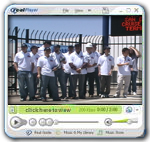UCSD Researchers Test Wireless Technologies in Simulated Medical Disaster Response Drill
San Diego, CA, May 16, 2005 -- As 200 passengers waited to board their vessel at San Diego's Cruise Ship Terminal, two terrorists opened fire and took hostages. Law enforcement was quickly alerted, but the terrorists detonated an explosive device that released a hazardous agent. That hypothetical scenario kicked off a full-dress disaster drill on May 12 organized by San Diego's Metropolitan Medical Strike Team (MMST). The simulation brought together police, SWAT, fire, HazMat and other first responders as well as a contingent of more than a dozen scientists and engineers from the University of California, San Diego and the California Institute for Telecommunications and Information Technology (Calit2).
|
"MMST brings these cross-agency groups together to see how they work, and what we are trying to do is make those processes work more seamlessly," said Ramesh Rao, Calit2's division director at UCSD and co-principal investigator on a two-year-old project called WIISARD (Wireless Internet Information System for Medical Response in Disasters). "From the Calit2 perspective, it's an opportunity for WIISARD to incorporate new technologies in a live drill that brings together real first responders from the community."
Researchers $4 million WIISARD project -- funded by NIH's National Library of Medicine -- shadowed first responders around the Cruise Ship Terminal, while simultaneously testing several new technologies. Jacobs School of Engineering computer science and engineering professor Bill Griswold and Ph.D. candidate Neil McCurdy tested their prototype Reality Flythrough. "This is a ubiquitous video system," explained Griswold. "It constructs a 3D virtual environment dynamically out of live video streams that are positioned in space, which you can stitch together so you get a 3D scene you can surf on a server."
|
After the drill, Griswold and McCurdy said the Reality Flythrough's use of the mesh network was a success. "We were able to get two high-quality video streams going at 10 frames per second, about 200K bytes per second over the network," explained Griswold. "We successfully roamed across three mesh nodes and got excellent coverage of the scene." McCurdy will offer details of the software engineering project in a presentation at the third annual International Conference on Mobile Systems, Applications and Services next month in Seattle.
"Reality Flythrough is probably the most mature application we're testing," said WIISARD principal investigator Leslie Lenert, a professor in the UCSD School of Medicine. "You don't have to try in your head to figure out where a person is when they're sending their signal." Added Rao, who is also a professor of electrical and computer engineering in the Jacobs School: "It is part of creating a situational awareness in a chaotic environment where a disaster has struck."
Another new technology demonstrated for the first time during the drill let first responders enhance the quality of care provided to victims. Five wireless-enabled PDAs were outfitted with software to help first responders keep track of victims' locations and triage status. "We have this new provider interface for capturing data," explained Lenert. "The electronic data is captured at the point of triage and while they're caring for patients, and this information can be transmitted automatically via the Internet back to hospitals and a command center."
|
"MMST has realized that law enforcement is an integral part of medical disaster response, and to better coordinate that, they anticipate that technologies like this can be useful in communicating from law enforcement to medical responders without distracting law enforcement from their duties," said Griswold. "We've also had some interest from SWAT officials because these technologies would allow SWAT teams to communicate information silently back to their commanders. Currently they have to use hand signals or radios, both of which put them at risk from exposing their positions."
Reality Flythrough and the new handheld interface for first responders require substantial wireless connectivity, and for the disaster drill, researchers from Calit2 and Ericsson set up a wireless "mesh" network. "It was probably our biggest success during the drill," said Lenert. "We were able -- without excessive work -- to deploy an 802.11 bubble the length of this whole pier, giving wireless connectivity to this whole area and supporting all our operations in a seamless fashion."
The network consisted of a series of four 802.11b Wi-Fi access points piggybacking on each other and sharing their combined access to a third-generation EVDO (data optimized) cellular network. "So the bandwidth that one first responder used did not have to come from the nearest box that was serving that responder," said Rao. "You could suck in bandwidth from the various gateways that fed this mesh network, and make it available to whatever applications needed it. Reconfigurability and rapid adaptability are examples of things introduced in this network, and they flow out of other Calit2 projects, including RESCUE and Adaptive Systems."
|
The first-responder community has welcomed the UCSD team and worked closely with the university researchers and their corporate partners. "We recognize their faces, we can wander in and out of their spaces and they're comfortable with us being there," noted Rao. "We are even starting to speak a similar language."
As for when the WIISARD technologies will be commonly available to first responders in a crisis, that day may not be far off. "What I expect is that in two to three years we will see the first commercial handhelds that do the types of data collection we're doing, but only if the infrastructure to do it is available," said WIISARD PI Lenert. "So I expect very rapid commercialization of this technology."
The WIISARD team is now looking ahead to November, when San Diego will stage a massive medical disaster response drill at the Del Mar Fairgrounds. "We've been in a mode of building infrastructure in the past year," said Lenert. "Now we can focus on applications."
Related Links
WIISARD
NIH/National Library of Medicine
MMST Exercise, San Diego Cruise Ship Terminal Image Gallery
Media Contacts
Media Contact: Doug Ramsey, (858) 822-5825, dramsey@ucsd.edu




